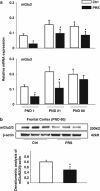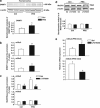Pharmacological activation of group-II metabotropic glutamate receptors corrects a schizophrenia-like phenotype induced by prenatal stress in mice
- PMID: 22089319
- PMCID: PMC3280642
- DOI: 10.1038/npp.2011.274
Pharmacological activation of group-II metabotropic glutamate receptors corrects a schizophrenia-like phenotype induced by prenatal stress in mice
Abstract
Prenatal exposure to restraint stress causes long-lasting changes in neuroplasticity that likely reflect pathological modifications triggered by early-life stress. We found that the offspring of dams exposed to repeated episodes of restraint stress during pregnancy (here named 'prenatal restraint stress mice' or 'PRS mice') developed a schizophrenia-like phenotype, characterized by a decreased expression of brain-derived neurotrophic factor and glutamic acid decarboxylase 67, an increased expression of type-1 DNA methyl transferase (DNMT1) in the frontal cortex, and a deficit in social interaction, locomotor activity, and prepulse inhibition. PRS mice also showed a marked decrease in metabotropic glutamate 2 (mGlu2) and mGlu3 receptor mRNA and protein levels in the frontal cortex, which was manifested at birth and persisted in adult life. This decrease was associated with an increased binding of DNMT1 to CpG-rich regions of mGlu2 and mGlu3 receptor promoters and an increased binding of MeCP2 to the mGlu2 receptor promoter. Systemic treatment with the selective mGlu2/3 receptor agonist LY379268 (0.5 mg/kg, i.p., twice daily for 5 days), corrected all the biochemical and behavioral abnormalities shown in PRS mice. Our data show for the first time that PRS induces a schizophrenia-like phenotype in mice, and suggest that epigenetic changes in mGlu2 and mGlu3 receptors lie at the core of the pathological programming induced by early-life stress.
Figures





Similar articles
-
Epigenetic modifications of GABAergic interneurons are associated with the schizophrenia-like phenotype induced by prenatal stress in mice.Neuropharmacology. 2013 May;68:184-94. doi: 10.1016/j.neuropharm.2012.04.013. Epub 2012 Apr 28. Neuropharmacology. 2013. PMID: 22564440 Free PMC article.
-
Levels of the Rab GDP dissociation inhibitor (GDI) are altered in the prenatal restrain stress mouse model of schizophrenia and are differentially regulated by the mGlu2/3 receptor agonists, LY379268 and LY354740.Neuropharmacology. 2014 Nov;86:133-44. doi: 10.1016/j.neuropharm.2014.07.009. Epub 2014 Jul 22. Neuropharmacology. 2014. PMID: 25063582
-
mGlu2 metabotropic glutamate receptors restrain inflammatory pain and mediate the analgesic activity of dual mGlu2/mGlu3 receptor agonists.Mol Pain. 2011 Jan 14;7:6. doi: 10.1186/1744-8069-7-6. Mol Pain. 2011. PMID: 21235748 Free PMC article.
-
Epigenetic Alterations in Prenatal Stress Mice as an Endophenotype Model for Schizophrenia: Role of Metabotropic Glutamate 2/3 Receptors.Front Mol Neurosci. 2018 Nov 30;11:423. doi: 10.3389/fnmol.2018.00423. eCollection 2018. Front Mol Neurosci. 2018. PMID: 30564095 Free PMC article. Review.
-
The preclinical properties of a novel group II metabotropic glutamate receptor agonist LY379268.CNS Drug Rev. 2007 Winter;13(4):444-64. doi: 10.1111/j.1527-3458.2007.00024.x. CNS Drug Rev. 2007. PMID: 18078428 Free PMC article. Review.
Cited by
-
Modulation of schizophrenia-related genes in the forebrain of adolescent and adult rats exposed to maternal immune activation.Schizophr Res. 2015 Oct;168(1-2):411-20. doi: 10.1016/j.schres.2015.07.006. Epub 2015 Jul 20. Schizophr Res. 2015. PMID: 26206493 Free PMC article.
-
Specific activation of mGlu2 induced IGF-1R transactivation in vitro through FAK phosphorylation.Acta Pharmacol Sin. 2019 Apr;40(4):460-467. doi: 10.1038/s41401-018-0033-7. Epub 2018 Jun 26. Acta Pharmacol Sin. 2019. PMID: 29946167 Free PMC article.
-
Exposure to caregiver maltreatment alters expression levels of epigenetic regulators in the medial prefrontal cortex.Int J Dev Neurosci. 2013 Dec;31(8):804-10. doi: 10.1016/j.ijdevneu.2013.10.001. Epub 2013 Oct 10. Int J Dev Neurosci. 2013. PMID: 24120634 Free PMC article.
-
Isolating pathogenic mechanisms embedded within the hippocampal circuit through regional vulnerability.Neuron. 2014 Oct 1;84(1):32-39. doi: 10.1016/j.neuron.2014.08.030. Neuron. 2014. PMID: 25277453 Free PMC article. Review.
-
Targeting metabotropic glutamate receptors for novel treatments of schizophrenia.Mol Brain. 2017 Apr 26;10(1):15. doi: 10.1186/s13041-017-0293-z. Mol Brain. 2017. PMID: 28446243 Free PMC article. Review.
References
-
- Angelucci F, Brenè S, Mathé AA. BDNF in schizophrenia, depression and corresponding animal models. Mol Psychiatry. 2005;10:345–352. - PubMed
-
- Belichenko PV, Hagberg B, Dahlstrom A. Morphological study of neocortical areas in Rett syndrome. Acta Neuropathol. 1997;93:50–61. - PubMed
-
- Benneyworth MA, Xiang Z, Smith RL, Garcia EE, Conn PJ, Sanders-Bush E. A selective positive allosteric modulator of metabotropic glutamate receptor subtype 2 blocks a hallucinogenic drug model of psychosis. Mol Pharmacol. 2007;72:477–484. - PubMed
-
- Bishop JR, Ellingrod VL, Moline J, Miller D. Association between the polymorphic GRM3 gene and negative symptom improvement during olanzapine treatment. Schizophr Res. 2005;77:253–260. - PubMed
Publication types
MeSH terms
Substances
Grants and funding
LinkOut - more resources
Full Text Sources
Medical

